The Least Grebe (Tachybaptus dominicus) stands as a diminutive marvel in the avian world, captivating observers with its unique characteristics and charming demeanor.
As the smallest member of the grebe family, this water bird inhabits a diverse range of freshwater ecosystems across the Americas.
With a compact body, a distinctive rounded head, and a striking blackish-green plumage, the Least Grebe is easily recognizable.
Notable features include a white eye ring, a crested appearance during the breeding season, and proficient diving skills, showcasing its adaptability to aquatic environments.
The species comprises five recognized subspecies, each adding nuances to its size and coloration.
From the southern US through Central and South America, the Least Grebe thrives in habitats such as ponds, and slow-flowing rivers, leaving an indelible mark on the rich tapestry of avian diversity in its range. Stay focused.
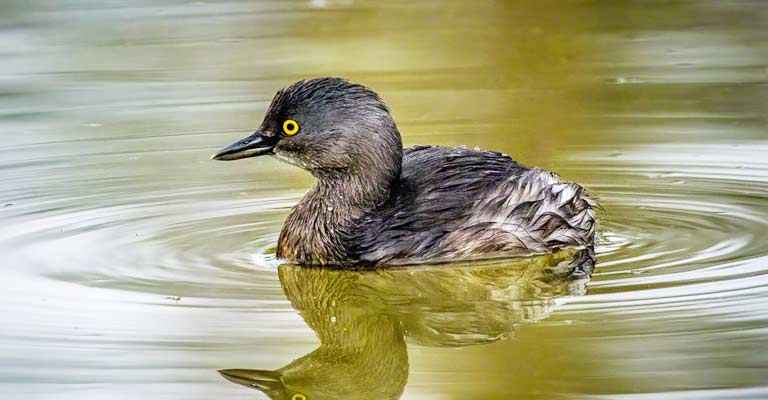
How to Identify Least Grebe?
The Least Grebe (Tachybaptus dominicus) is a small water bird that belongs to the Grebe family.
Identifying this species can be a rewarding experience for birdwatchers, as it possesses unique features that set it apart from other grebes.
Here are some of the key points to help you confidently identify the Least Grebe:
Size and Appearance
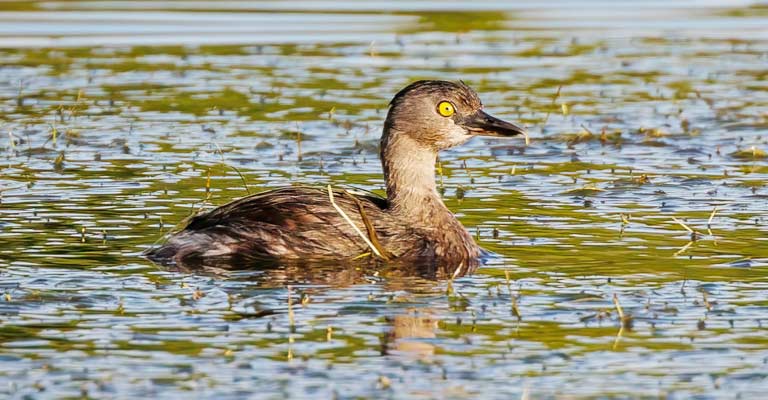
The Least Grebe is the smallest member of the Grebe family, measuring about 9 to 10 inches (23 to 25 cm) in length.
It has a compact body with a short neck and a distinctive, rounded head. The plumage is mostly dark, with a glossy blackish-green color on the upperparts and a rich chestnut color on the neck.
Facial Markings
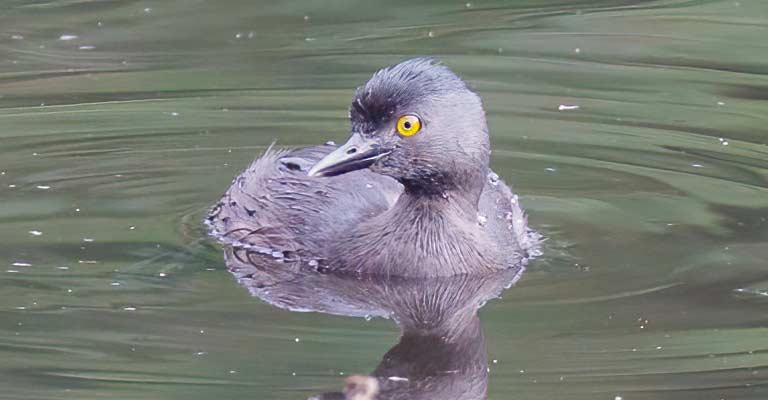
One of the most striking features of the Least Grebe is its facial markings. It has a prominent white eye-ring that contrasts with its dark face, creating a distinctive and eye-catching appearance.
This white eye-ring is a key identifier when observing the bird in the field.
Bill and Beak
The bill of the Least Grebe is relatively short and slender. It is pointed, allowing the bird to efficiently catch small aquatic prey.
The bill is usually dark in color, adding to the overall contrast with the white eye-ring and enhancing its facial features.
Crested Appearance
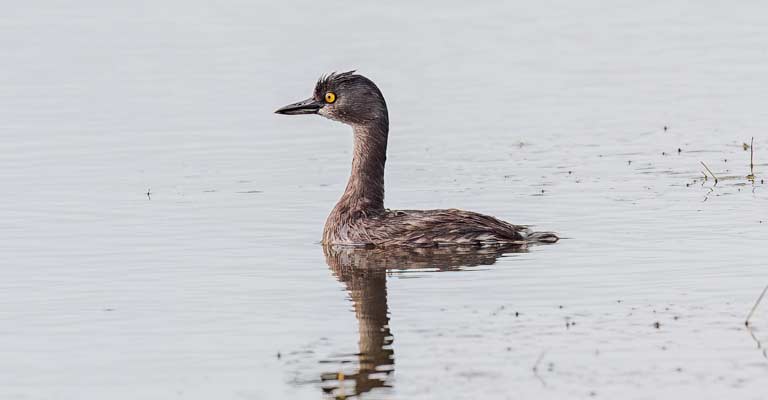
During the breeding season, the Least Grebe exhibits a noticeable crest on its head.
This crest can be raised or flattened depending on the bird’s mood or behavior. The crest adds a distinct feature to its appearance, aiding in identification.
Behavior and Habitat
Observing the behavior and habitat of the Least Grebe is crucial for identification. These birds prefer freshwater habitats such as ponds, lakes, and slow-moving rivers with abundant vegetation.
They are skilled divers, spending a significant amount of time underwater in search of small fish and invertebrates.
Vocalizations
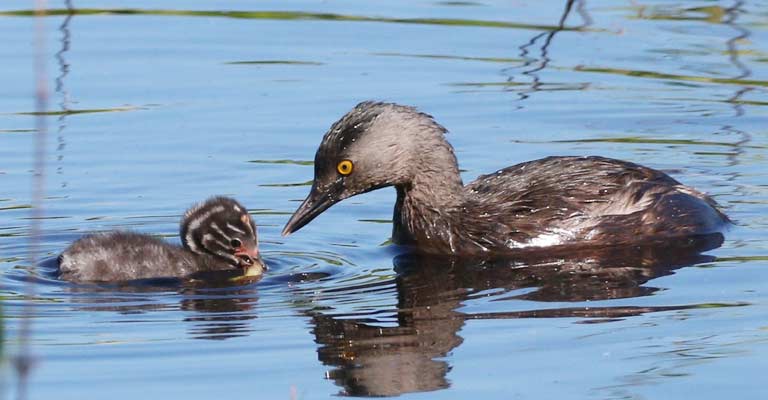
The Least Grebe has a unique set of vocalizations that can be helpful in identification. Its calls are often described as a series of high-pitched, yelping or whinnying sounds.
Familiarizing yourself with these distinct vocalizations can assist in locating and identifying the bird.
Breeding Season Displays
During the breeding season, Least Grebes engage in courtship displays. These displays may include synchronized swimming, head bobbing, and mutual preening.
Observing such behaviors, especially in pairs, can be a clue to the bird’s identity.
Range and Distribution
The Least Grebe is primarily found in the Americas, from the southern United States through Central and South America.
Understanding its range and distribution can help eliminate confusion with similar-looking species in other parts of the world.
Identifying the Least Grebe requires a combination of visual cues, behavioral observations, and an understanding of its distinctive features.
By paying attention to size, facial markings, bill characteristics, behavior, vocalizations, and habitat preferences, birdwatchers can confidently recognize and appreciate this charming water bird in its natural environment.
Taxonomy of Least Grebe
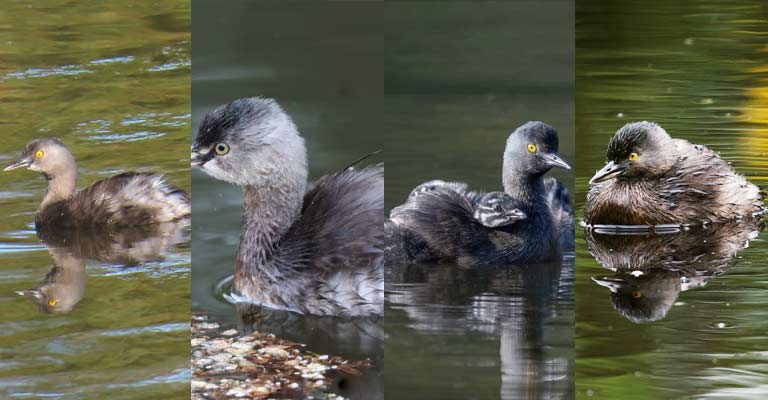
The brief table below will tell you everything about the taxonomy details of the Least Grebe:
| Taxonomic Rank | Classification |
| Domain | Eukaryota |
| Kingdom | Animalia |
| Phylum | Chordata |
| Class | Aves |
| Order | Podicipediformes |
| Family | Podicipedidae |
| Genus | Tachybaptus |
| Species | T. dominicus |
The Least Grebe (Tachybaptus dominicus) exhibits a fascinating diversity across its five recognized subspecies, each distinguished by variations in size and color.
These subspecies inhabit distinct geographical regions, contributing to the rich tapestry of avian life. Here’s a brief overview of each subspecies:
- T. d. brachypterus: Found in southern Texas and Mexico extending south to Panama, T. d. brachypterus showcases the adaptability of the Least Grebe in diverse environments of North and Central America.
- T. d. bangsi: Restricted to southern Baja California, Mexico, T. d. bangsi stands out as the smallest and palest of the subspecies, demonstrating how environmental factors influence their physical characteristics.
- T. d. dominicus: The nominate subspecies, T. d. dominicus, thrives in the northern Caribbean, including the Bahamas, Greater Antilles, Virgin Islands, and southern Florida. Its presence in these regions contributes to the unique ecological dynamics of the area.
- T. d. brachyrhynchus or T. d. speciosus: Inhabiting South America, from Colombia and Venezuela to Trinidad and Tobago, and extending south to northern Argentina and southern Brazil, T. d. brachyrhynchus or T. d. speciosus underscores the Least Grebe’s adaptability in the diverse ecosystems of the continent.
- T. d. eisenmanni: Restricted to the lowlands of western Ecuador, T. d. eisenmanni is a subspecies recognized by some authorities. Its specific habitat preference showcases the localized adaptations that can occur within the overall species.
The varied distribution of these subspecies emphasizes the Least Grebe’s ability to thrive in a range of habitats, contributing to the ecological balance and biodiversity across the Americas.
Understanding these regional nuances adds depth to our appreciation of the species’ adaptability and the intricate interplay between environment and avian evolution.
Common Food of Least Grebe
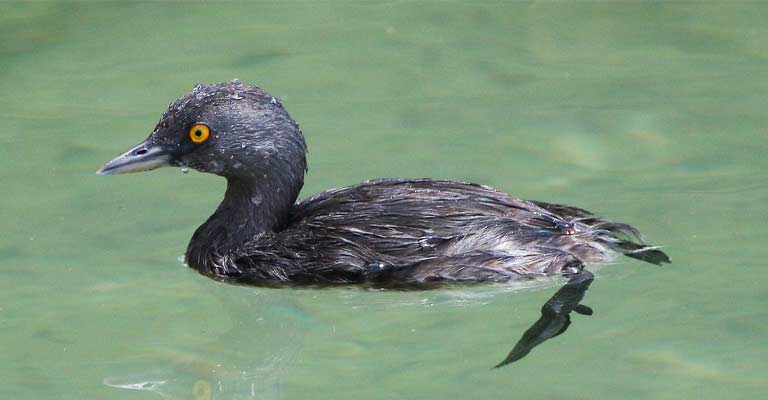
The Least Grebe (Tachybaptus dominicus) is primarily carnivorous, feeding on a variety of aquatic organisms.
Its diet is well-suited to its semi-aquatic lifestyle, and the bird relies on its diving capabilities to forage for prey beneath the water’s surface. The common food items of the Least Grebe include:
- Small Fish: The grebe feeds on small fish, utilizing its agile swimming and diving abilities to catch them underwater.
- Insects and Aquatic Invertebrates: Insects and aquatic invertebrates, such as beetles, dragonfly nymphs, and water bugs, constitute a significant portion of the Least Grebe’s diet.
- Crustaceans: Crayfish and other crustaceans are also part of their diet, providing a source of protein and nutrients.
- Amphibians: Least Grebes may consume small amphibians like tadpoles and frogs, particularly in areas where they are abundant.
Adaptable and opportunistic, the Least Grebe’s diet reflects its dependence on the rich biodiversity found in freshwater habitats, where it thrives by exploiting the diverse array of prey available.
Least Grebe’s Life History
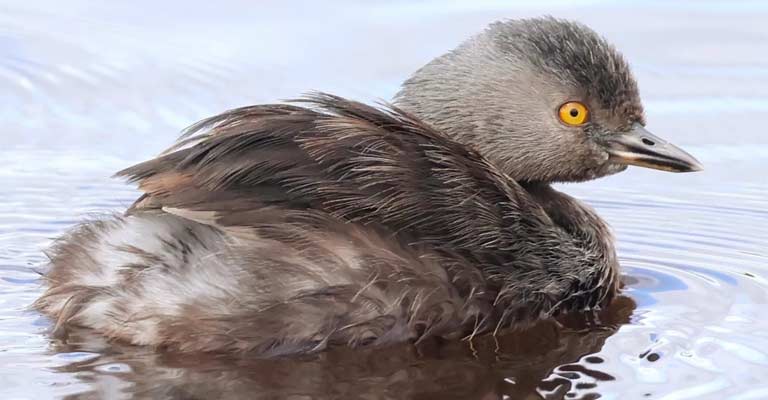
The Least Grebe (Tachybaptus dominicus) is a charming water bird known for its small size and distinctive features.
Understanding its life history provides valuable insights into its habitat, range, nesting behavior, breeding habits, susceptibility to diseases, conservation status, and the necessary treatment measures.
Habitat
Least Grebes are predominantly found in freshwater habitats, including ponds, lakes, slow-flowing rivers, and marshes.
They show a preference for areas with abundant aquatic vegetation, offering both nesting sites and a diverse range of prey.
Range Map
The Least Grebe’s range extends from the southern United States through Central and South America.
A comprehensive range map illustrates its distribution, showcasing the bird’s adaptability to various wetland environments within this geographical span.
Nesting
These birds construct floating nests anchored to vegetation, creating a secure platform for their eggs. The nests are often hidden within reeds or other aquatic plants, protecting from predators.
The female typically lays a clutch of eggs, and both parents take turns incubating them.
Here’s a table summarizing nesting details of the Least Grebe (Tachybaptus dominicus):
| Nesting Details | Facts |
| Clutch Size | Usually 2 to 5 eggs |
| Number of Broods | Often have multiple broods in a season |
| Egg Length | Approximately 2.4 – 2.7 cm (0.94 – 1.06 inches) |
| Egg Width | Approximately 1.7 – 1.9 cm (0.67 – 0.75 inches) |
| Incubation Period | Around 20 to 22 days |
| Nestling Period | Chicks are precocial, capable of swimming and diving shortly after hatching |
| Egg Description | Smooth, elliptical, and usually white or pale blue |
| Nest Construction | Floating nest anchored to aquatic vegetation, often hidden within reeds or other plants |
| Incubation Responsibilities | Shared by both male and female, taking turns to incubate the eggs |
| Parental Care | Both parents are actively involved in caring for and protecting the nestlings |
These details provide a snapshot of the Least Grebe’s nesting habits, showcasing their reproductive behavior and parental care strategies.
Breeding
During the breeding season, Least Grebes engage in elaborate courtship displays, including synchronized swimming, head bobbing, and mutual preening.
The birds form monogamous pairs and cooperate in raising their offspring. The chicks are precocial, capable of swimming and diving shortly after hatching.
Diseases
Like many water birds, Least Grebes can be susceptible to various diseases. Common avian diseases, such as avian botulism or avian influenza, may pose a threat to their populations.
Treatment
Effective treatment for diseases affecting Least Grebes involves a combination of habitat management, monitoring, and, in some cases, medical intervention.
Efforts to reduce pollution, control invasive species, and preserve natural habitats contribute to the overall health and resilience of the species.
Conservation
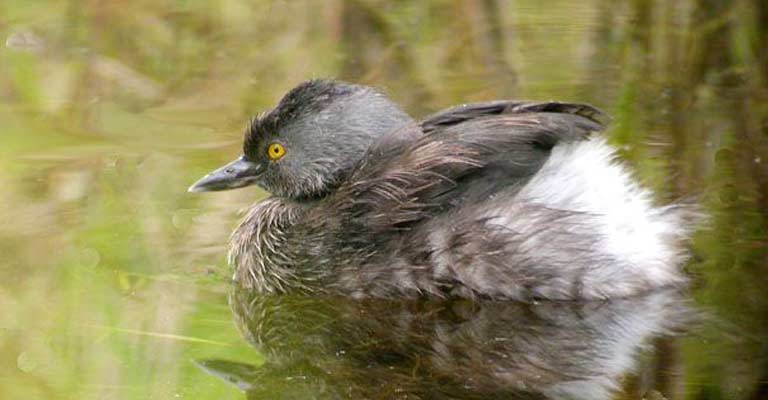
While the Least Grebe is not currently considered globally threatened, localized declines can occur due to habitat destruction and pollution.
Conservation measures include the protection and restoration of wetland habitats, sustainable water management, and raising awareness about the importance of these ecosystems.
The life history of the Least Grebe is intricately tied to its ability to adapt to diverse freshwater environments.
Understanding and addressing the challenges it faces, from habitat loss to potential diseases, are crucial for ensuring the continued well-being of this delightful water bird.
Conservation efforts play a pivotal role in preserving the habitats that sustain the Least Grebe and maintaining the delicate balance of ecosystems it calls home.
10 Fun Facts About Least Grebe
The Least Grebe (Tachybaptus dominicus) may be small in size, but it boasts a fascinating array of characteristics that make it a delight for bird enthusiasts.
From its unique behaviors to its distinct appearance, here are 10 fun facts about the charming Least Grebe.
- Smallest Grebe: The Least Grebe holds the title of the smallest member in the Grebe family, measuring a mere 9 to 10 inches (23-25 cm) in length. Its diminutive size adds to its charm and makes it stand out among its larger avian relatives.
- Distinctive Facial Markings: This water bird sports a striking look with a dark face contrasting a prominent white eye-ring. The combination of these facial markings enhances its appeal and aids in easy identification.
- Crested Appearance: During the breeding season, the Least Grebe showcases a crested appearance on its head. This distinctive feature adds a touch of elegance and flair to its overall demeanor.
- Acrobatic Divers: Least Grebes are skilled divers, expertly navigating underwater to catch small fish, insects, and aquatic invertebrates. Their agile and acrobatic diving techniques make them efficient hunters.
- Precocial Chicks: The chicks of the Least Grebe are precocial, meaning they are born with their eyes open and are capable of swimming and diving shortly after hatching. This adaptation allows them to quickly join their parents in the water.
- Elaborate Courtship Displays: During the breeding season, these birds engage in elaborate courtship displays that include synchronized swimming, head bobbing, and mutual preening. These displays are both charming and essential for pair bonding.
- Varied Vocalizations: Least Grebes communicate with a range of vocalizations, from high-pitched yelps to whinnying sounds. These varied calls serve purposes such as territory marking and signaling between mates.
- Multiple Broods: Least Grebes are known for having multiple broods in a single breeding season, showcasing their adaptability and reproductive success in their chosen habitats.
- Nesting Adaptations: Their floating nests, anchored to aquatic vegetation, provide a secure platform for their eggs. This nesting adaptation helps protect their offspring from potential predators.
- Global Range: The Least Grebe’s range spans from the southern United States through Central and South America, highlighting its adaptability to various freshwater environments.
The Least Grebe may be small, but its unique characteristics and behaviors make it a captivating species for bird enthusiasts.
Whether it’s their crested appearance, acrobatic diving skills, or multiple broods in a season, there’s no shortage of fascinating facts to discover about these charming water birds.
Wrapping Up
The Least Grebe stands as a testament to nature’s diversity and adaptability. Its small size belies a wealth of captivating features, from distinctive facial markings to acrobatic diving skills.
With its crested appearance during the breeding season and the efficiency in raising multiple broods, the Least Grebe embodies the beauty and resilience of avian life.
Observing their nesting habits, courtship displays, and vocalizations adds a layer of appreciation for these charming water birds, underscoring the importance of preserving their habitats.
As stewards of our environment, understanding and protecting the Least Grebe ensures the continuity of a species that enriches our natural world. Best of luck.